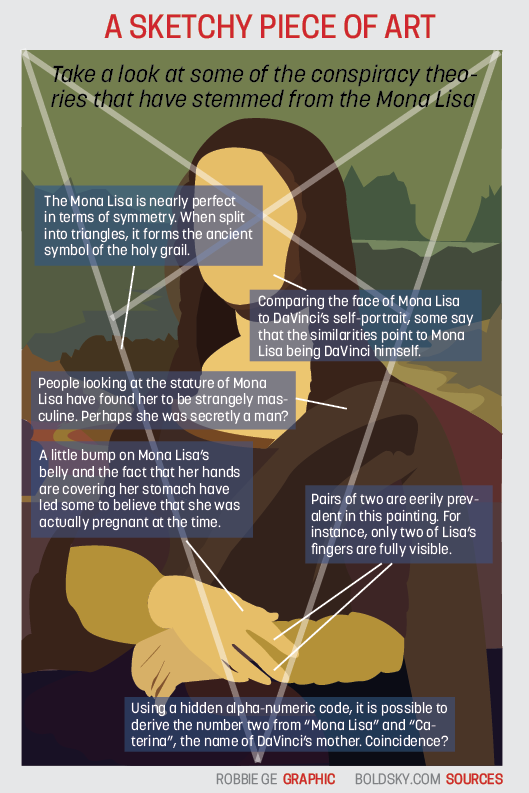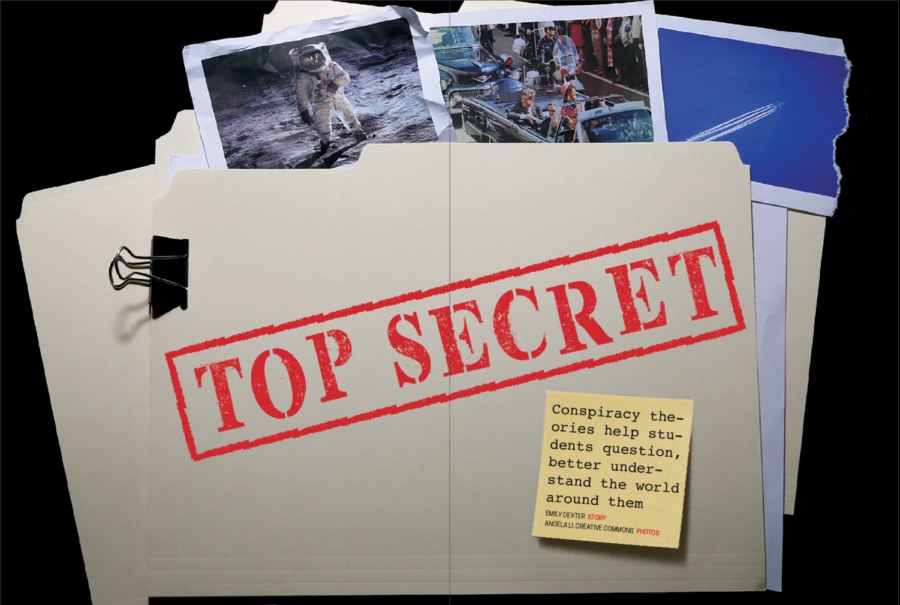Your donation will support the student journalists of Carmel High School - IN. Your contribution will allow us to purchase equipment and cover our annual website hosting costs.
Is It True?: Conspiracy theories help students question, better understand the world around them
December 13, 2018

THEORY TIME: Senior Olivia Krall makes the illuminati symbol with her hands for a photo. According to Krall, she started Conspiracy Theory Club after visiting the Denver airport.
Senior Olivia Krall was far from the first person to think that something seems “off” about the Denver International Airport. After all, as the airport’s website explains, the place has underground tunnels, gargoyles and a plaque that references the mysterious New World Airport Commission. The airport’s construction went over budget, and then there’s the blue horse sculpture whose creator Luis Jiménez died while making it. The horse’s glowing eyes are rumored to represent the Four Horsemen of the Apocalypse.
“I went there over the summer, and it’s true,” Krall said. “It was all gloomy and dark, and (the horse’s) eyes glow red from any way you look at it.”
Krall said the theories surrounding the Denver airport were the first conspiracy theories that truly sparked her interest.
“I stumbled upon that my sophomore year, and that kind of became a running joke in English (class),” Krall said. “We’d always talk about the Denver airport, and then one time someone just walked in and said, ‘Australia doesn’t exist. I don’t believe it.’ That was the point when I was like, ‘We have to have a club. We have to have a place to talk
The following school year, Krall founded Conspiracy Theory Club. Since then, Krall said the club has seen members give presentations on topics ranging from the moon landings and the assassination of John F. Kennedy to the strategic arrangement of all Outback Steakhouses in pentagrams and the evils of bananas. Krall said she sees the club as a safe, relaxing place where students can unleash their creativity.
“If someone walks up to the front of the class and says that bananas are evil while wearing a banana suit, you can’t help but laugh at that,” Krall said. “It’s ridiculous, and it’s fun. We all know it’s ridiculous, but we’re going to pretend together.”
As Krall has found in her experience with Conspiracy Theory Club, there are plenty of people willing to “pretend together” when it comes to conspiracy theories. In fact, over the past year, both more Americans and more Hoosiers have Google searched for the topic of conspiracy theories than for the topic of the moon landings, according to data from Google Trends. Those statistics become especially relevant for the new year, which will mark the 50th anniversary of the first moon landing, back in 1969.
Krall said the moon landings have been a topic of discussion in Conspiracy Theory Club.
“That’s the mother of all conspiracy theories. That’s like the biggest one,” Krall said. “Everyone knows the theory that the moon landing was faked.”
According to Julian Knudson, Conspiracy Theory Club member and senior, there are two main schools of thought concerning the moon landings. Either they were authentic, and humans landed on the moon for the first time in 1969, or the landings were faked, probably somewhere in the American Southwest. Knudson said he chooses to disagree with both of these ideas.
 “I believe that we were on the moon the whole time, and we faked the moon landing on the moon,” Knudson said. “We made everyone think that the 1960s was the first time we landed on the moon. So we sent a little probe there, landed on the moon. Very easy to fake. We were actually there hundreds of years before that. We just didn’t want anyone to know.”
“I believe that we were on the moon the whole time, and we faked the moon landing on the moon,” Knudson said. “We made everyone think that the 1960s was the first time we landed on the moon. So we sent a little probe there, landed on the moon. Very easy to fake. We were actually there hundreds of years before that. We just didn’t want anyone to know.”
Knudson said that even though he can joke that he seriously believes in this theory, the real reason he created it was for fun, not to uncover any hidden truths.
“I can jokingly say I’m very serious about all these things, but in reality most of it’s just conjec-
ture,” Knudson said. “It’s very un-likely to really be true.”
Tony Dunham, Conspiracy Theory Club sponsor and English teacher, said he agrees with the idea that the club’s theories are more for fun than serious consideration.
“I think it’s fun to stir the pot when it comes to kind of outlandish claims,” Dunham said. “So the Conspiracy Theory Club we have here at Carmel is not a very serious club. They’re not denying certain major historical events.”
Despite the club’s lack of seriousness, Dunham said, there is another side to the coin; conspiracy theories can help students to question the world around them and see things from different perspectives.
Krall said she agrees that conspiracy theories can help students to think for themselves. She said that one club member, for example, proposed a new theory about the moon, just as Knudson did. According to this theory, the moon doesn’t exist at all, so astronauts couldn’t have landed on it. Instead, the moon is no more than a projection.
“(With) the moon landing, no one thinks about the moon itself as a projection, so now you’re understanding it, or trying to understand it, in a new context,” Krall said. “I think that’s really interesting, to see the world from a different perspective and try to see what you can prove. Obviously there’s evidence that the moon landing was real. We can see all of the videos and the evidence, but there’s also (that) you can interpret that evidence in different ways. I think that applies to real life.”
Knudson said he also feels that conspiracy theories are a way to better understand the world around him. Last year, for instance, he said he noticed an increasing trend in the school’s intercom system going off at odd times, and decided to create an explanation for the phenomenon.
According to Knudson’s theory, CHS is a Horcrux, just like Tom Riddle’s diary or Nagini the snake in the wizarding world of Harry Potter. He said former Principal John Williams and current Principal Tom Harmas are the wizards who turned CHS into a Horcrux. Knudson said he explains the strange incidents with the school’s intercom as evidence of Williams’ split soul living inside the building.
“I always live by the philosophy of questioning everything,” Knudson said. “You never know when someone’s lying to you, or when an organization is lying to you.
“I think it’s very important that as young people, we are able to determine things and facts for ourselves, as opposed to just laying down and listening to our authority figures, so to say. I think it’s a skill that can be very valuable in our later lives. Conspiracy theories are kind of silly, but they’re a way to manifest that (idea).”
 Krall said the idea of determining facts for oneself also extends to our understanding of history.
Krall said the idea of determining facts for oneself also extends to our understanding of history.
“So much of what we see about the world is from one perspective. It’s from whoever came here last, and they got to choose and alter what we see in history. So when you look back, you don’t get every perspective. You don’t get the perspective of the minorities, and the people who had to struggle and the people who were conquered,” Krall said. “I think conspiracy theories are a vital part of history. They’re vital to understanding history in a new and a different light.”
Evidence exists to support Krall’s claims, as some conspiracy theories have been proven true over the years. Just last year, for example, the educational resource ciaagentedu.org published a list of five CIA-related theories that have been confirmed as truthful. The theories included CIA efforts to weaponize the process of weather modification, and the use of a fake vaccination program to locate Osama bin Laden.
Even so, Krall said an important distinction is that conspiracy theories should not be used to question or dispute all of history. If a person believes in every conspiracy theory, historical or modern, then that person is no longer thinking for themself and considering all perspectives.
“If you view conspiracy theories as a way to be open to every perspective and as a way to evaluate all the perspectives around you, I think that’s a positive mindset that everyone should share,” Krall said. “But if you view them as a way to discredit others and to discredit genuinely proven facts and proven ideas, then it can be a negative aspect.”
Dunham said he agrees that this distinction needs to be made.
He said, “I like the idea of being able to question everything, but I don’t like the idea of questioning facts. It’s fun to talk like, ‘(Was) the Denver airport built by the Masons, and is it a secret hideout for the Illuminati?’ That’s intriguing and funny to me, but denying the Holocaust is not. I feel like even in the last year it’s become a little more divisive. You can’t just yell ‘fake news’ or ‘conspiracy theory’ at actual fact reporting.”
As long as this distinction is made, Krall said, conspiracy theories have the potential to help students question and understand the world for themselves.
Knudson said he agrees with that idea.
“You don’t want to grow up and always listen to your parents, your teachers, and then when you get to the real world, you’re suddenly like, ‘Oh no, what do I do? Who am I? What’s my identity?’” Knudson said. “You want to be able to form that identity for yourself, and conspiracy theories are a fun, social way that you can question things around you and become an individual.”

